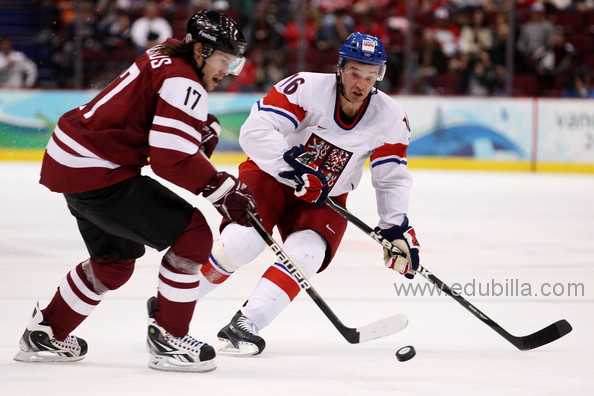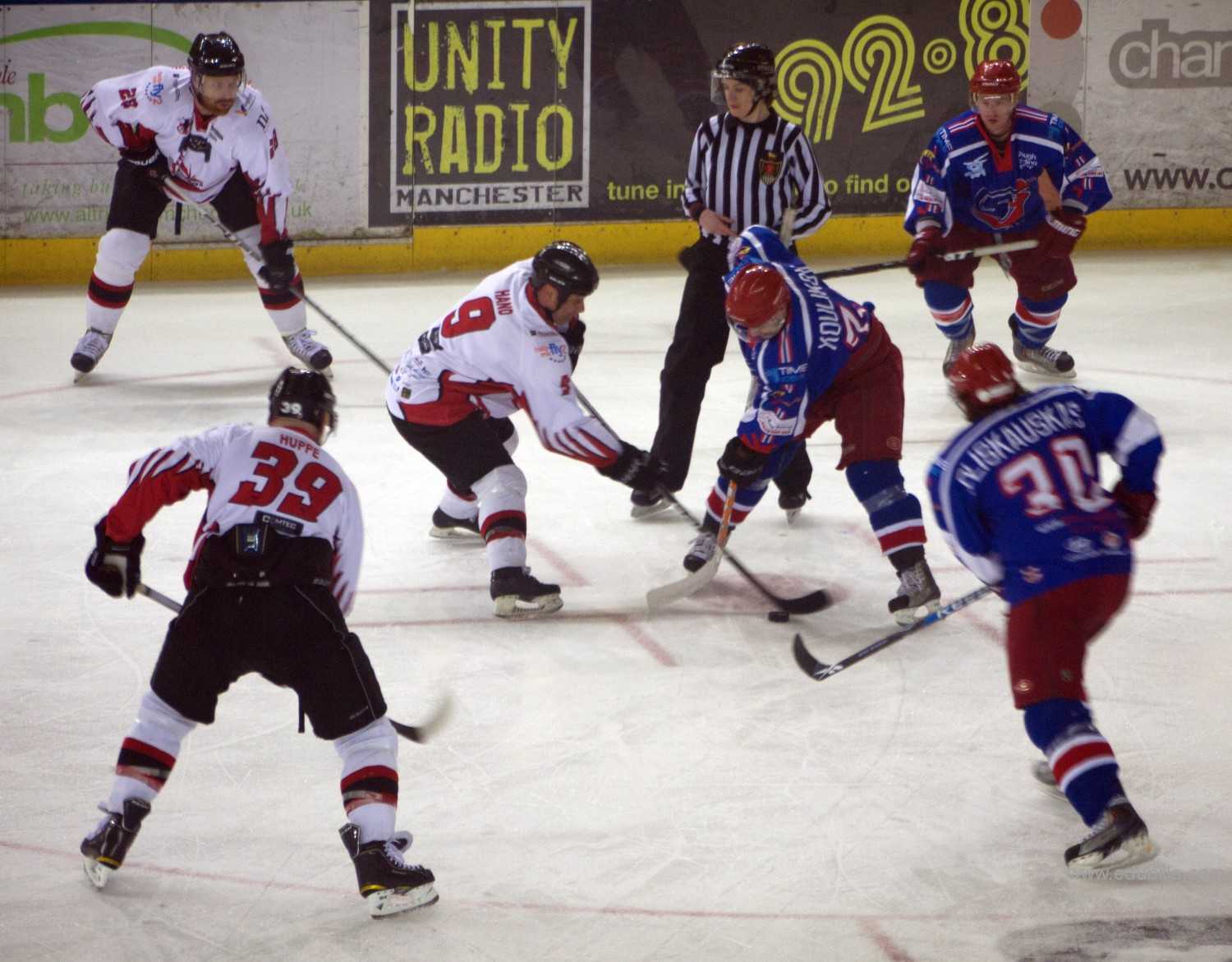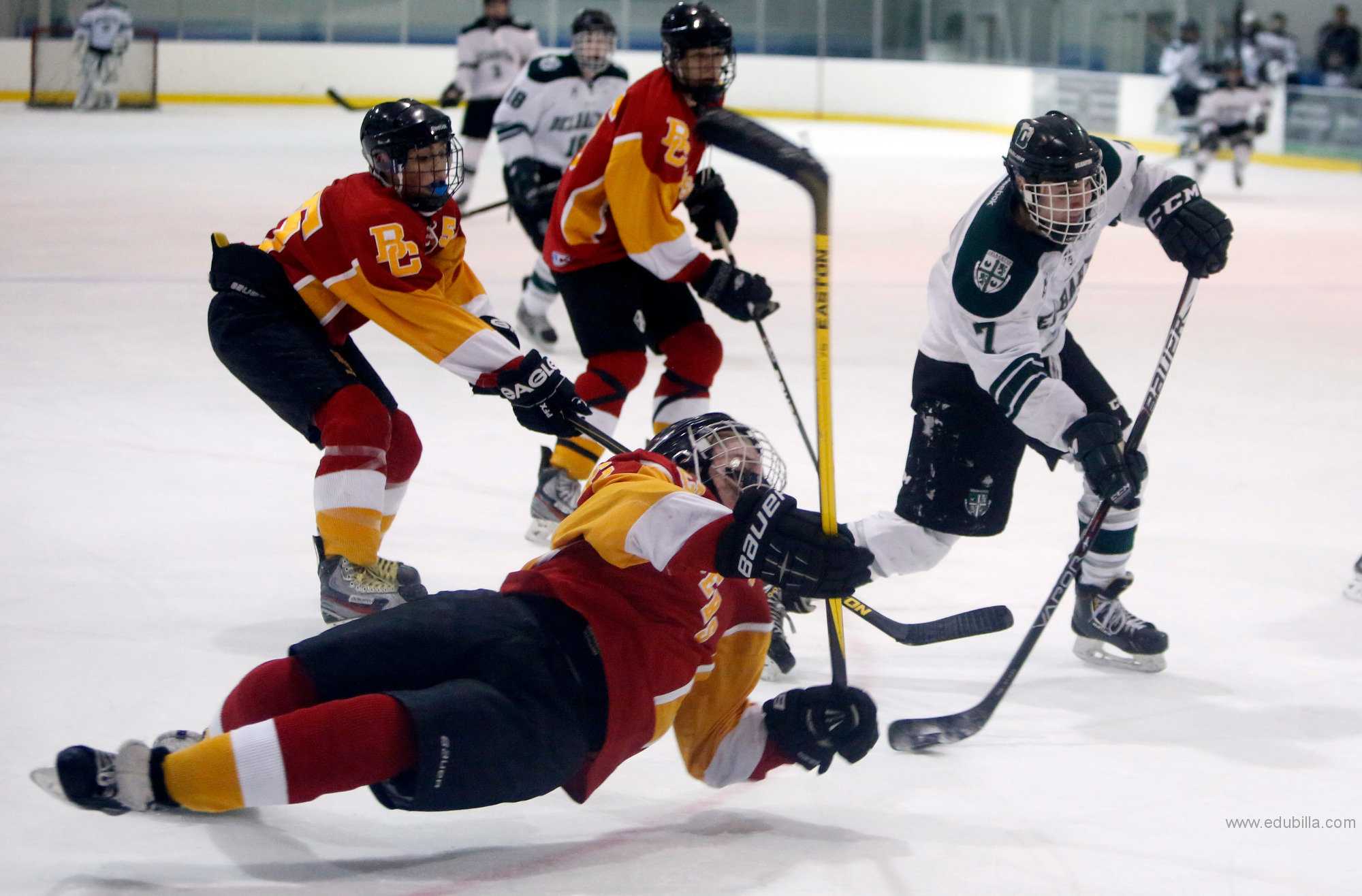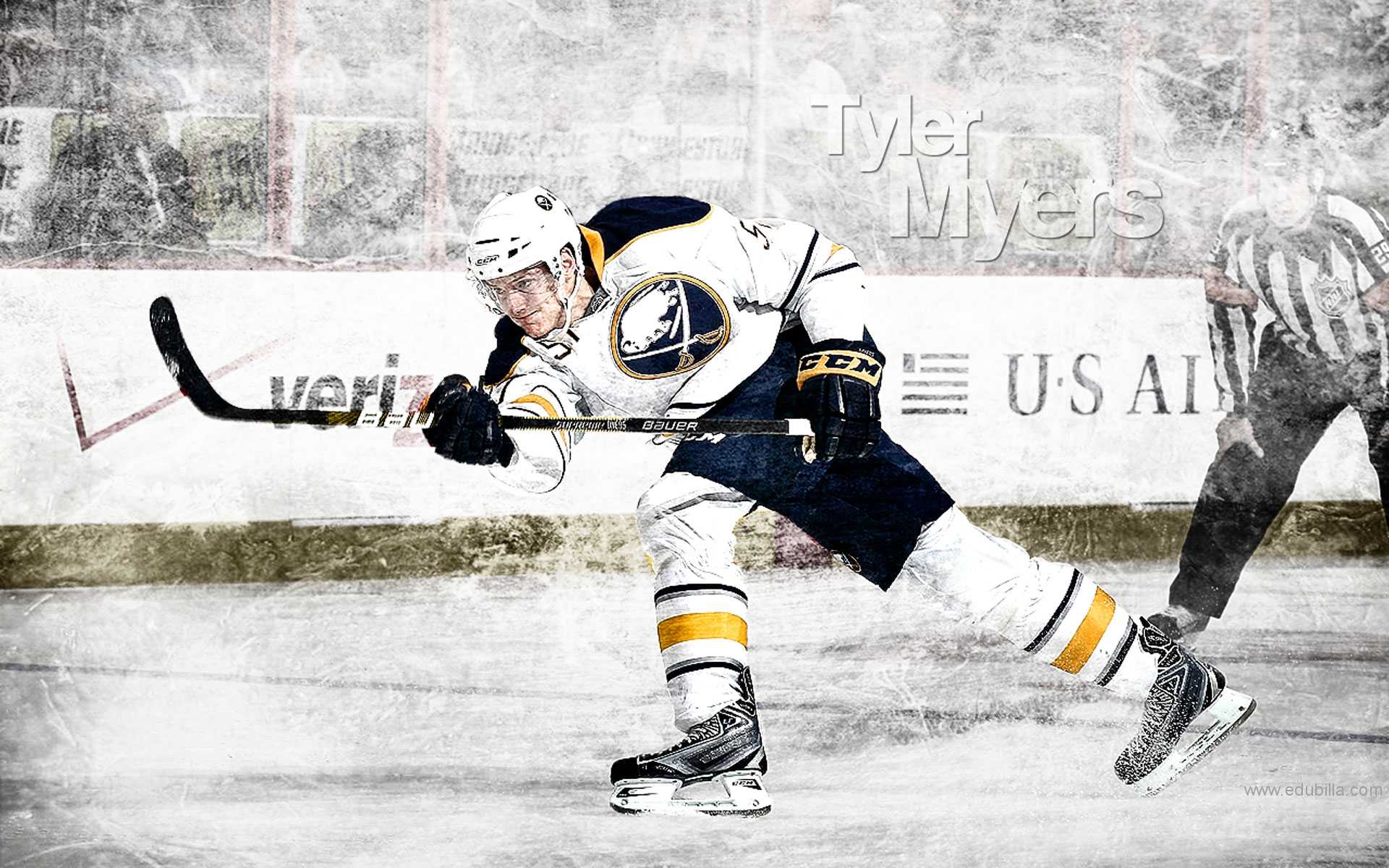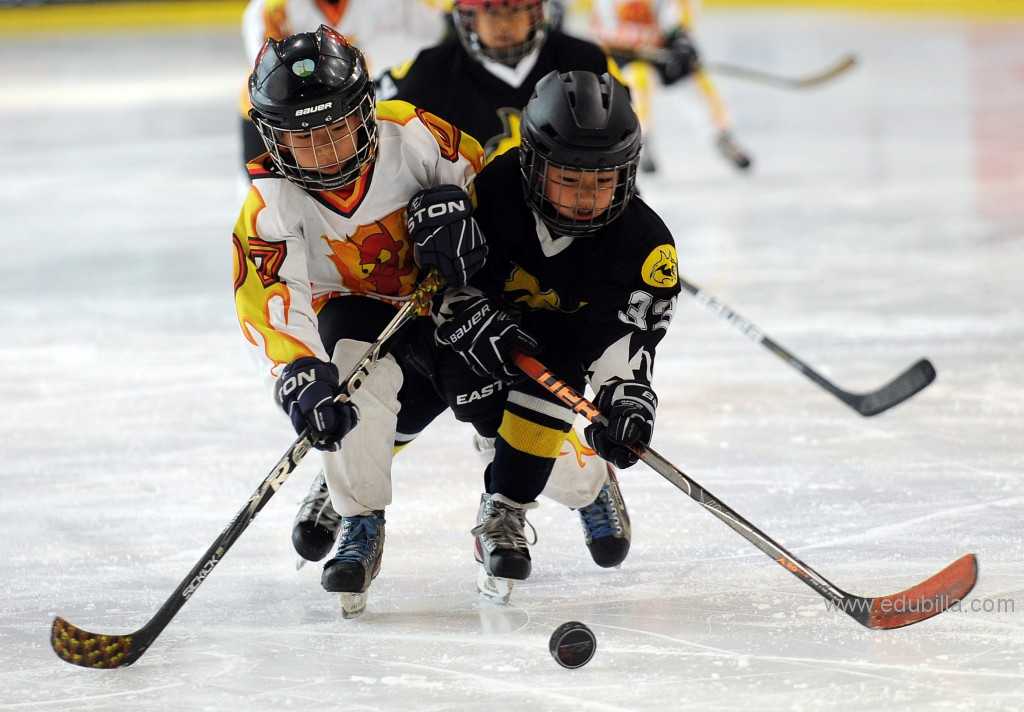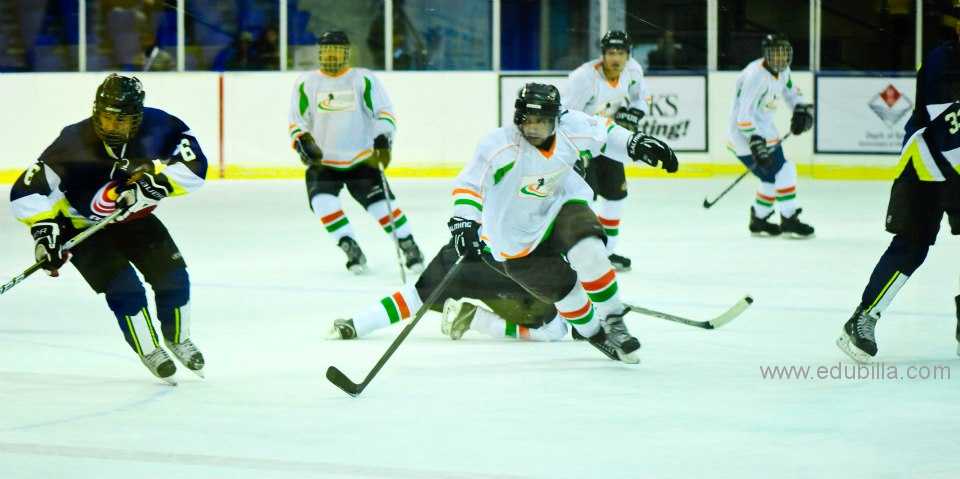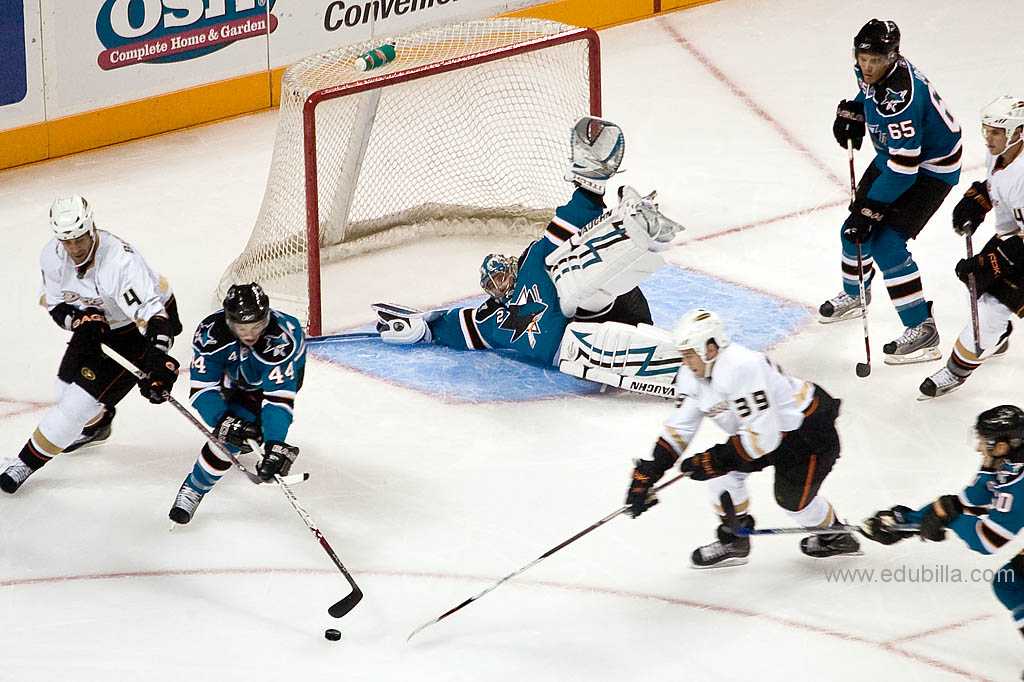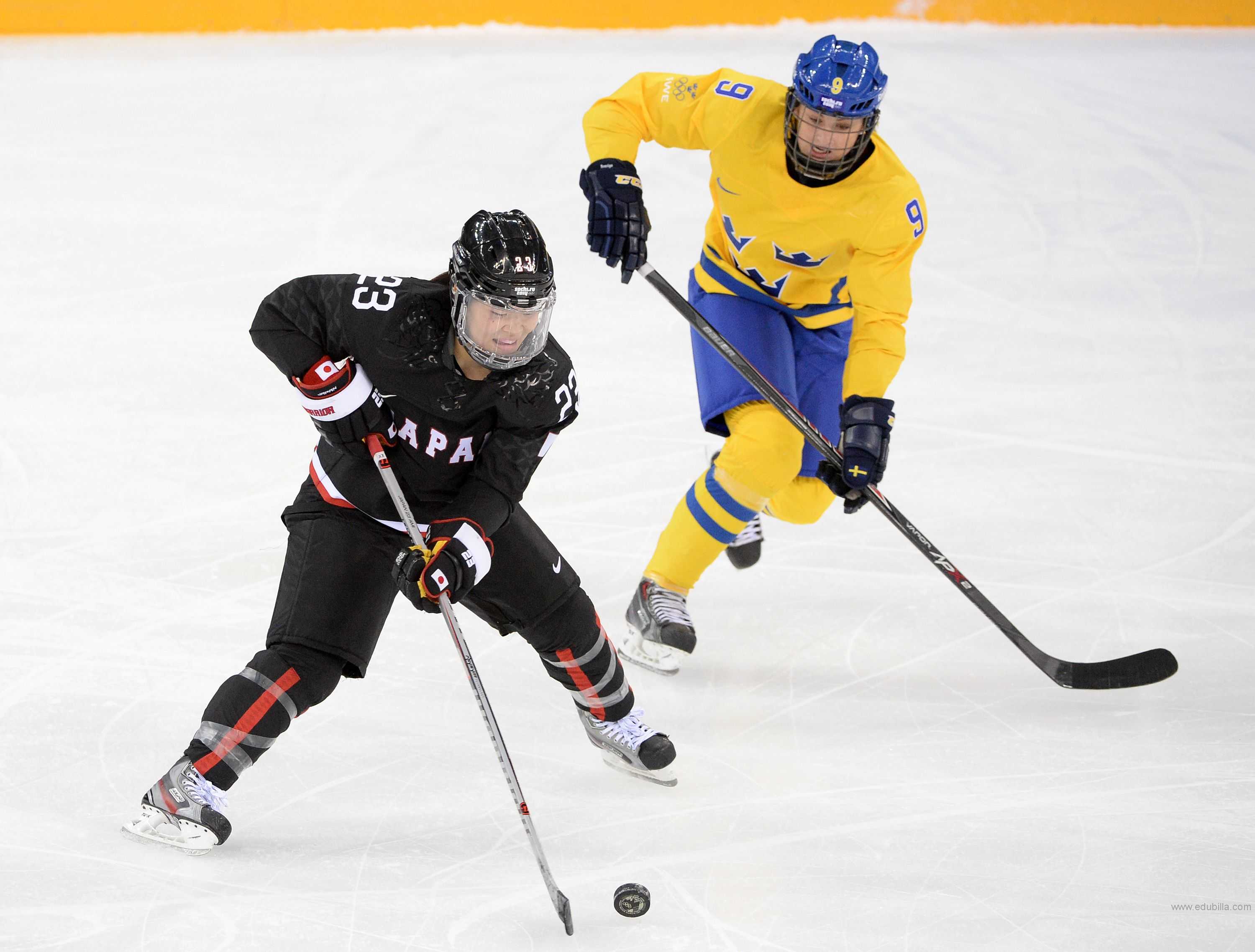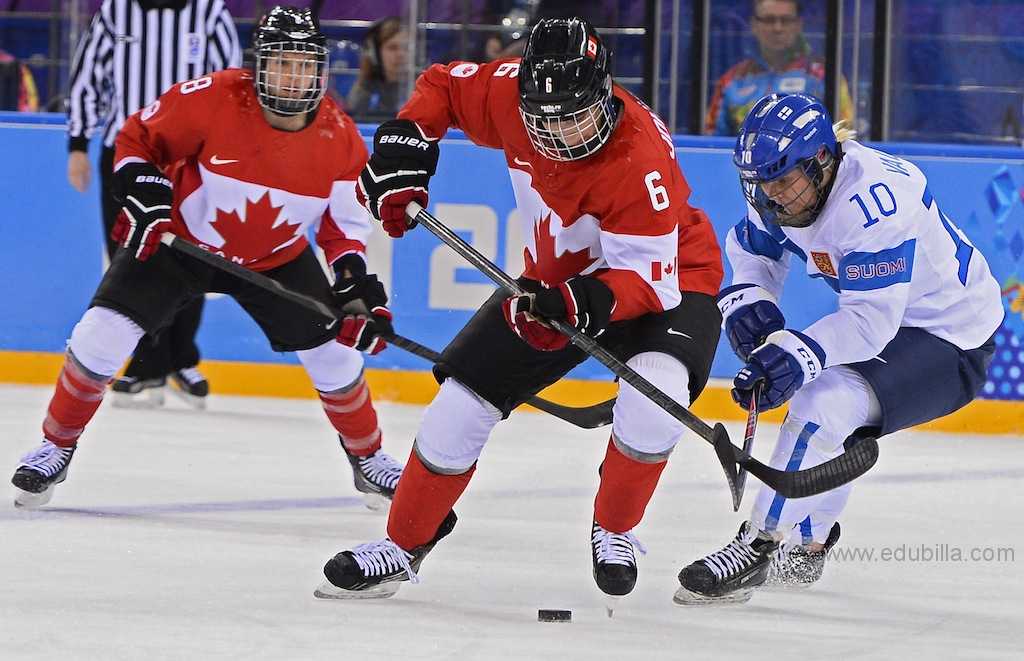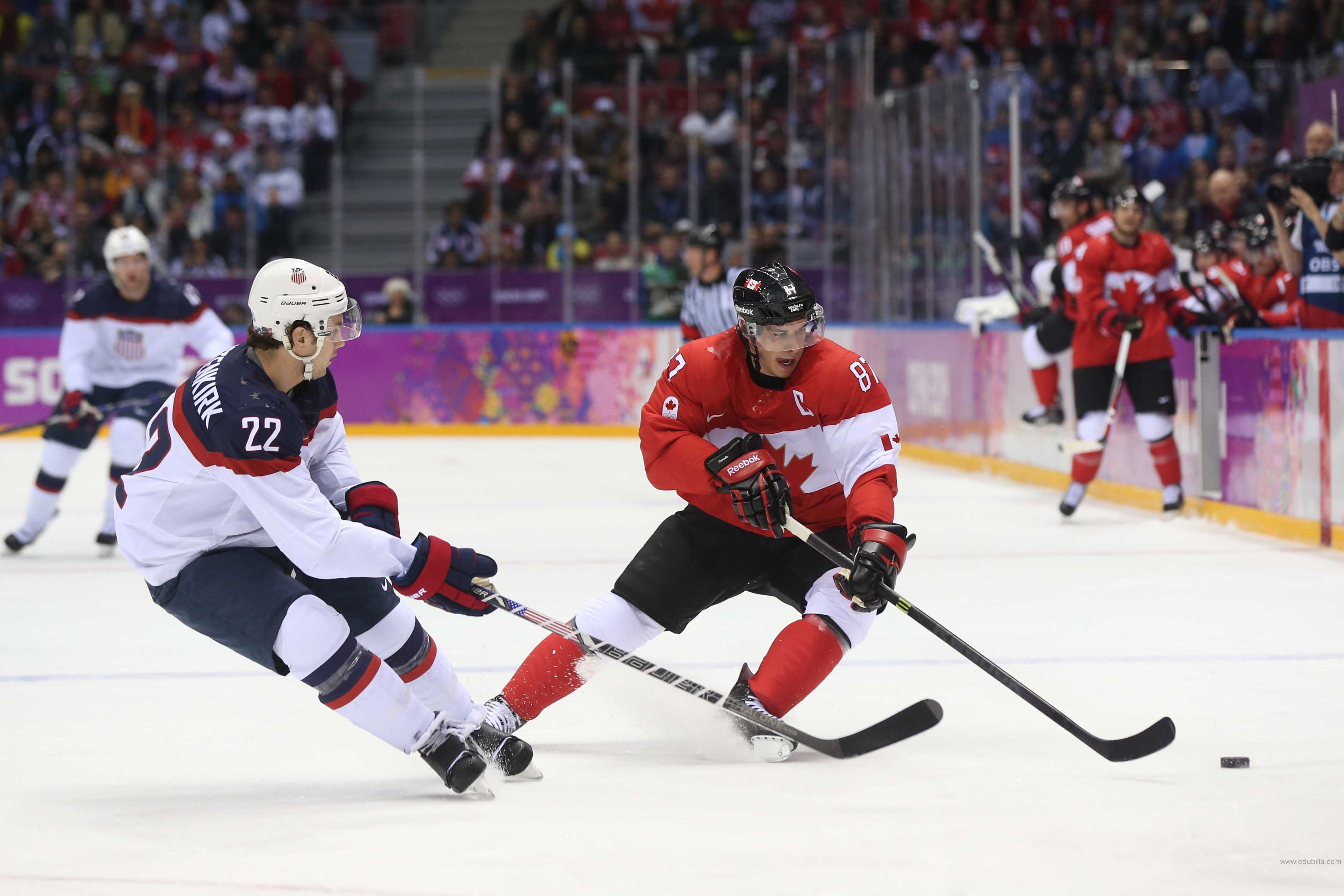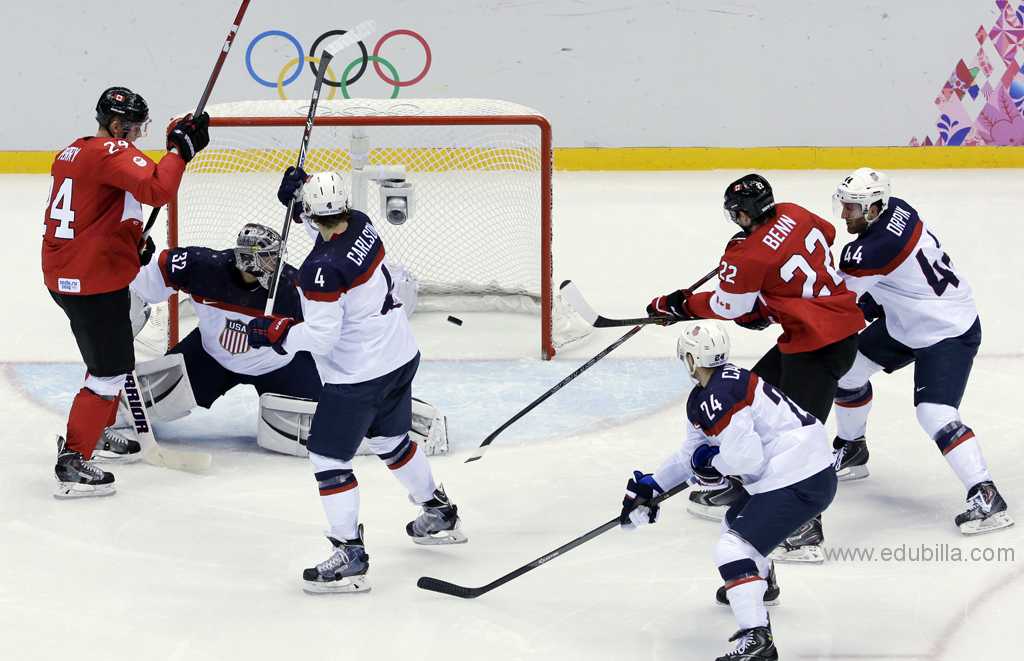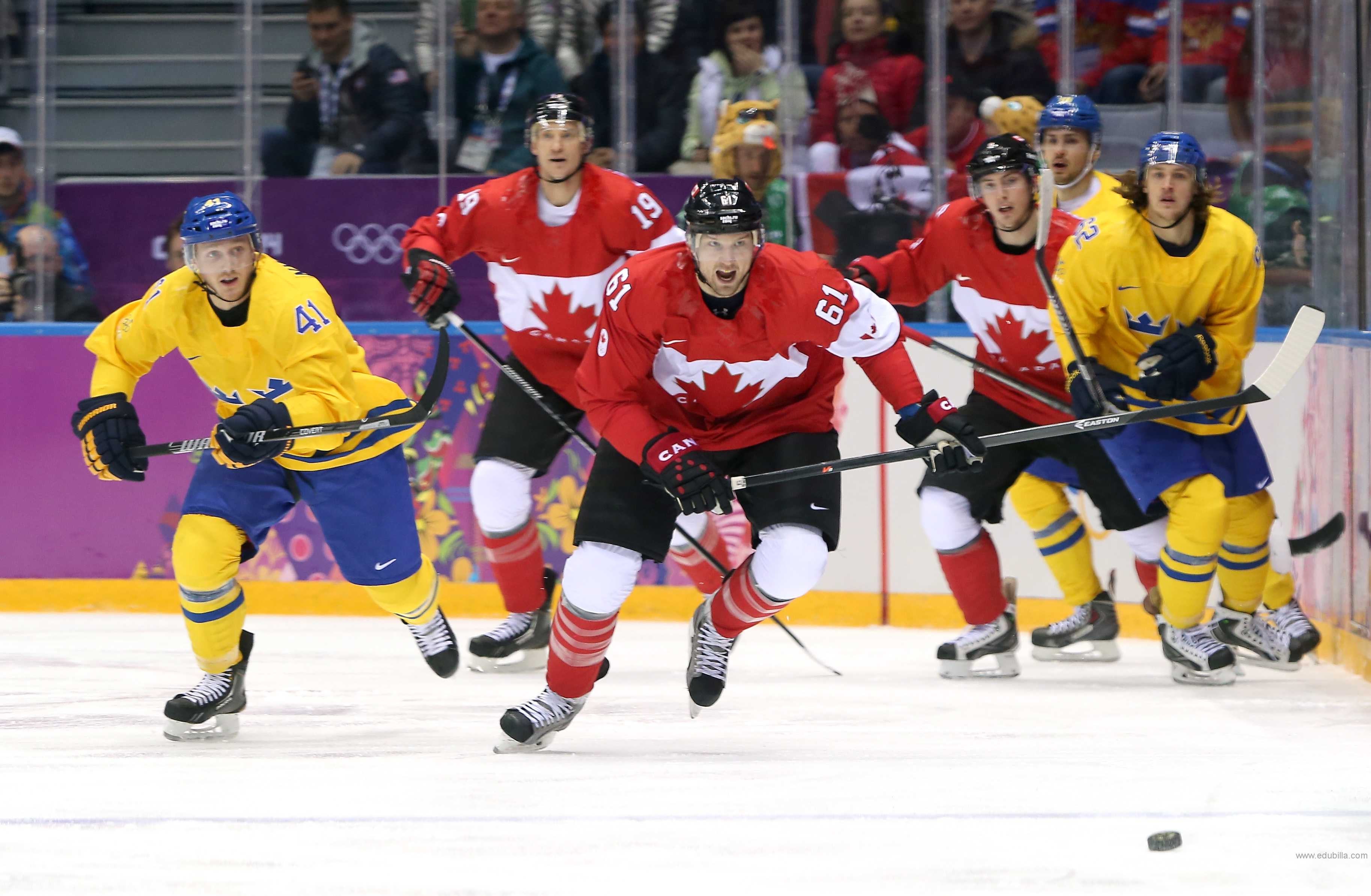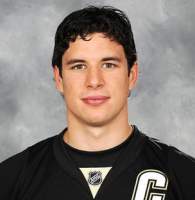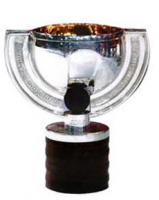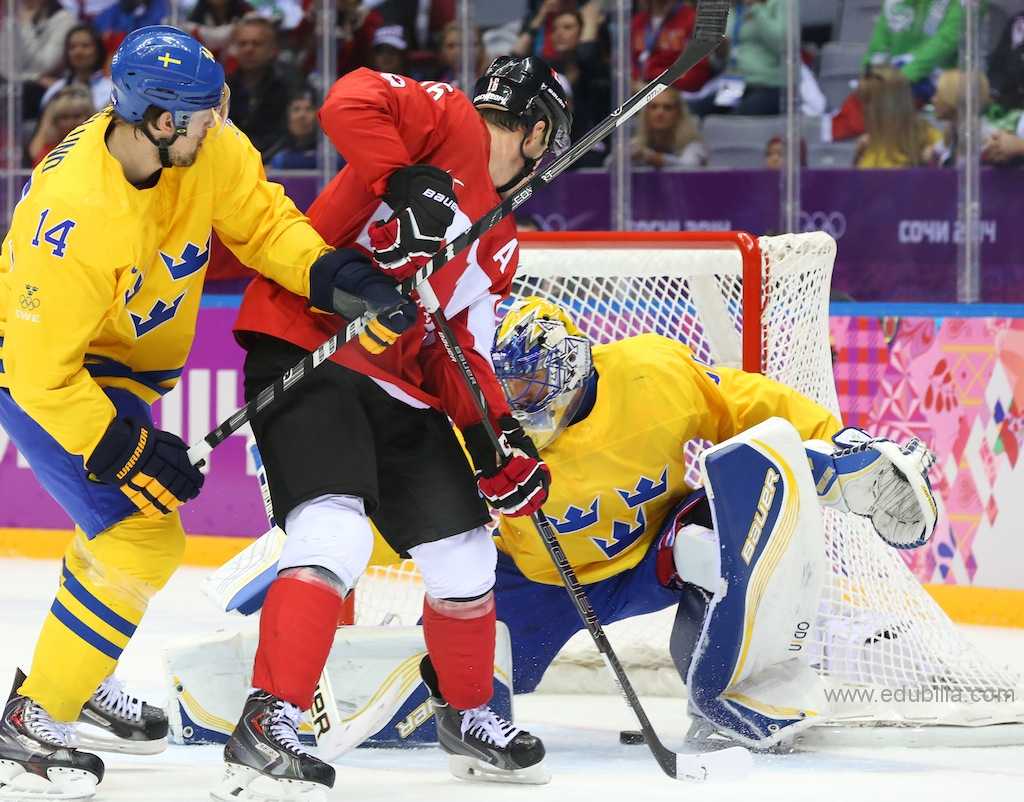
Overview Of Ice hockey
Ice hockey is a team sport played on ice in which two teams of skaters use sticks to shoot a hard rubber puck into their opponent's net to score points. In some countries such as Canada, the United States, and some European countries such as Latvia and Sweden, it is often known simply as "hockey"; the name "ice hockey" is more used in countries where "hockey" generally refers to field hockey or both sports are almost as popular (such as South America, Asia, Africa, Australasia, and some European countries like Germany, the Netherlands, Spain and the United Kingdom). Ice hockey teams usually consist of four lines of three forwards, three pairs of defencemen, and two goaltenders. Five members of each team skate up and down the ice trying to take the puck and score a goal against the opposing team. Each team has a goaltender who tries to stop the puck from going into the goal.
National Hockey League (NHL):
A fast-paced physical sport (leading to the nickname "The Fastest Game on Earth"), hockey is most popular in areas of North America (particularly Canada and northern parts of the United States) and Europe. In North America, the National Hockey League (NHL) is the highest level for men's hockey and the most popular. Ice hockey is the official national winter sport of Canada,where the game enjoys immense popularity. Worldwide, there are ice hockey federations in 73 countries.
The sport is believed to be an off-shoot of stick and ball games invented elsewhere, particularly the games of the 1700s and 1800s in the United Kingdom. These games were brought to Canada and the United States and several similar winter games using informal rules developed, such as "shinney" and "ice polo". The first indoor hockey game was played on March 3, 1875, in Montreal, and some characteristics of that game such as the length of the ice rink and the use of a puck have been retained to this day. Amateur ice hockey leagues began in the 1880s, and professional ice hockey originated around 1900.
The Stanley Cup:
The Stanley Cup, emblematic of ice hockey club supremacy, was first awarded in 1893 to recognize the Canadian amateur champion and later became the championship trophy of the NHL. In the early 1900s, the Canadian rules were adopted by the Ligue International de Hockey sur Glace, the precursor of today's International Ice Hockey Federation (IIHF) and the sport was played for the first time in the Olympics in the Olympic Games of 1920.
International competitions:
In international competitions, the national teams of seven countries predominate: Canada, the Czech Republic, Finland, Russia, Slovakia, Sweden and the United States. Of the 66 medals awarded all-time in men's competition at the Olympics, only six medals were not awarded to one of those countries. In the annual Ice Hockey World Championships, 162 of 177 medals have been awarded to the seven nations:All 12 Olympic and 36 IIHF World Women's Championships medals have been awarded to one of these seven countries, and every gold medal in both competitions has been won by either Canada or the United States
Game Rules
Ice hockey rules define the parameters of the sport of ice hockey. The sport is governed by several organizations including the International Ice Hockey Federation (IIHF), the National Hockey League (NHL), Hockey Canada, USA Hockey and others. The rules define the size of the hockey rink where a game is played, the playing and safety equipment, the game definition, including time of play and whether tie-breaking methods are used and the actual playing rules themselves. The IIHF rule book is used in both amateur and professional leagues world-wide. The NHL's rule book is the basis for the rule books of most North American professional leagues. The IIHF, amateur and NHL rules evolved separately from amateur and professional Canadian ice hockey rules of the early 1900s.
Playing Surface:
There are five (5) lines on the ice, two (2) goal lines (both at the end of the ice), two (2) blue lines, separating the offensive/defensive zones from the neutral zone, and the centre red line.
The red line is not in play when making stretch passes. Before the NHL lockout in the 2004-05 seasons, players could not make two lined passes; resulted in offside.
Players:
Hockey is played with six (6) players on the ice for each team; five (5) skaters, one (1) goaltender.
The typical roster size of a hockey team is twenty (20) players; twelve (12) forwards, 6 defensemen, and two (2) goaltenders.
There are an unlimited amount of substitutions and they can happen at any time; during play and/or a stoppage of play; except when the defensive team ices the puck.
The goaltenders have limited control over the puck, there is a trapezoid behind the goal where goalies are allowed to handle the puck, if they play the pluck outside this area below the goal line, and it will result in a delay of game penalty. This trapezoid does not exist in international play.
Icing:
Icing is when the defending team shoots the puck down the ice, without touching another player, across two red lines, first one being the red centre line and the second being the goal line. The opposing team must touch the puck before the team who iced the puck, or the call will become void.
In international rules, the rule is “no touch” icing; meaning the play is called dead once the puck crosses the goal line.
The team who ices the puck is not allowed to substitute players during this stoppage of play.
Periods (regulation time):
Hockey is divided into three (3) period, first, second, and third; they are each twenty (20) minutes long, with intermissions in between.
The ice is to be flooded after warm-up and during first and second intermission.
Overtime:
If the game is still tied at the end of regulation, there is a sudden death overtime period; meaning, if a goal is scored during this period, the game is over.
During the NHL regular season, the overtime period is five (5) minutes long with 4-on-4 hockey. If the game is still tied after the overtime period, it results in a shootout.
In NHL playoff hockey, the sudden death overtime period(s) is twenty (20) minutes long with 5-on-5 hockey. The game will continue until there is a goal scored, there is no shootout.
Shootout:
If the game is still tied after the overtime period, a shootout ensues. Each team will have three (3) shooters. The team with the best out of three shots will win the game. If after the three shooters the game is still tied, its moves to a sudden death shootout; meaning the next shootout goal wins (if the team who chooses to shoot first scores, the team that shoots second has the chance to redeem themselves, if they miss, the game is over).
Penalties
Two Minute Minor Penalties
Hooking, slashing, delay of game, interference, goaltender interference, tripping, roughing, elbowing, boarding, cross checking, charging, holding, high sticking, kneeing, check from behind, spearing, unsportsmanlike conduct, two many men on the ice
Four Minute Double Minor Penalties
Any minor penalty that draws blood from the cause of the penalty
Five minute Major Penalties
The player must stay in the penalty box for the entire five (5) minutes, even if their short handed team is scored upon.
A player is allowed to serve the initial two (2) minute penalty, but the other player must stay in the penalty box.Penalties such as fighting, charging, hit from behind, and hit to the head.
Ten Minute Misconduct Penalties
The player must stay in the penalty box for the entire ten (10) minutes, even if their short handed team is scored upon.A player is allowed to serve the initial two (2) minute penalty, but the other player must stay in the penalty box.Penalties such as fighting, charging, hit from behind, unsportsmanlike conduct, and hit to the head.
Game Misconduct Penalties
The player is suspended for the remainder of the game and depending on the severity of the penalty, will receive additional suspension.Penalties such as charging, hit from behind, spearing, unsportsmanlike conduct, and hit to the head.Players are ejected from the game if they fight three (3) times in one game.
Power Play:
When a team is penalized, and depending the severity of the penalty, the opposing team is rewarded a power play; meaning the other team will be short handed for a distinct amount of time (refer to penalties).
If the team on the power plays gets a goal, the power play is now over.
If the short handed team scores while killing the power play, the power play is not over.
Penalty Shot:
A penalty shot is rewarded to the offensive player if he or she is on a breakaway and the defending obstructs the player enough so they do not get a shot off. Obstructions such as hooking, slashing, tripping, and holding. Also, if the goaltender throws his or her stick at the puck or players to prevent a goal, the player will be awarded with a penalty shot.
On a penalty shot, the shooter starts from centre ice and is only allowed one shot, even if there is a rebound.
Offside:
The puck must completely cross the offensive blue line before any player on the offence completely crosses the blue line.
Face-off:
A faceoff ensues every time there is a stoppage of play. A face off occurs in the centre of the rink at the beginning of each period and after every goal.
Shots on Goal:
A shot on goal (SOG) is when the shot results in a goal or a save by the goaltender.
A missed shot results the shot missing the goal completely or hitting the goal posts.
Points:
Points are rewarded to players who score and assist (primary and secondary) the goal.
Two points (2) are awarded to the winning team in the standings, while the losing team gets zero (0) points, unless they losing team loses in overtime or a shootout then they are awarded one point in standings.
Plus/Minus (+/-):
When a goal is scored, even strength (5 vs. 5), the offensive team players on the ice are rewarded with a +1 rating. The defending team players on the ice are given a -1 rating. This statistic in not in effect when teams are on the power play, unless the team that is short handed gets a goal.
Detailed Football Rules Can Be Downloaded From Documents
Equipments Need For Ice hockey
Helmet :
A helmet with strap, and optionally a face cage or visor, is required of all ice hockey players. Hockey helmets come in various sizes, and many of the older designs can also be adjusted by loosening or fastening screws at the side or at the back. Ice hockey helmets are made of a rigid but flexible thermoplastic outer shell, usually nylon or ABS, with firm vinyl nitrile foam padding inside to reduce shocks. Even with the helmet and visor/face cage, concussions and facial injuries are common injuries in the sport.
Neck guard:
For "skaters", a neck guard typically consists of a series of nylon or ABS plates for puncture resistance, with padding for comfort and fit and a tear-resistant nylon mesh outer covering. For goalies, the neck protector is usually a curved panel of clear Lexan and hangs just underneath the mask from nylon cords, somewhat in the manner of a metal military gorget. Both are intended to reduce the potential for injury to the neck or throat by a puck or skate blade.
Shoulder pads :
Hockey shoulder pads are typically composed of a passed vest with front and back panels, with velcro straps for closure, and soft or hard-shelled shoulder caps with optional attached upper arm pads. These pads primarily protect the chest, ribs, solar plexus, spine and shoulders against flying pucks and collisions with other players or the ice. They are not required by all recreational leagues ("no-check" leagues penalize offensive checking, and lower-skill leagues rarely see pucks leave the ice) and are often omitted for practice sessions not involving body contact, but they are virtually always worn by players during games.
Elbow pads:
Provides forearm and sometimes triceps protection against pucks in addition to a reinforced elbow cup. Elbow pads are vital for all hockey players. The pads can protect the elbow joint and arm bones from bruises and prevent fractures. The elbow pads cover the elbow joint and part of the upper and lower arms. Some elbow pads do have extensions that can cover the entire upper arm. The majority of elbow pads are adjustable and are secured with Velcro straps.
Hockey Jersey :
Covers the shoulder and elbow pads. Jerseys are color-coded and numbered for team and player identification, and teams, especially at upper skill levels, may have multiple jersey styles for home and away games. Traditional hockey jerseys are oversized, roughly square, and made using fabrics with limited elasticity. A "fight strap" is required to be used in most professional leagues; this connects the jersey to the inside of the pants and prevents an opponent in a fight pulling the player's jersey over their head. Newer jerseys are more form-fitting due to the use of elastic fabrics, and resemble NFL jerseys in their overall fit.
Hockey gloves:
Worn on the hands, player's gloves are constructed with a very thin leather palm and fingers, while providing substantially more padding to the outside of the hands; the gloves also reinforce the thumbs to prevent them bending backwards.
Hockey pants:
These are knee-length oversized shorts, which incorporate the thigh, pelvic, hip and tailbone pads, and cinch at the waist. They are often held up by a belt or suspenders.
Jockstrap or ladies' pelvic protector:
The jock is a protective cup which is designed to protect the genitals. The cup easily fits into a strap or some type of sports support. Some jock straps come with inbuilt garter belts so that one can wear long socks at the same time. Many companies now make "jock shorts" which are a jockstrap incorporated into a pair of boxer or athletic shorts, or into elastic shorts similar to "boxer briefs", which increases coverage of the garment and helps position the cup more securely against the player's anatomy without shifting.Similar garments, called "pelvic protectors" or informally "jillstraps", provide a hard shell protecting the female genitalia and the lower pelvis from impact.
Garter :
Garter belts are often used by players to hold up hockey socks. A garter is simply an elastic band that goes around the waist and has several straps that go down to the front and back of the legs. At the end of each strap is a clip or a hook which attaches to the sock. The latest garters belts come with Velcro straps which makes it easier to attach the socks.Many hockey pants and jock shorts now have built-in garters in the form of a velcro patch on the front and rear of the leg, which grab and hold the sock.
Shin guards:
Incorporating a kneepad as well, the shin guard has a hard plastic shell on the front and outside to protect against pucks, but usually has little or no protection on the calf. Shin guards help protect the knee joint and the frontal bones of the leg from pucks, sticks, skates, falls and other impacts. However, it is essential to buy proper shin guards. If the shin guard is too long it will slip down into the skate and prevent proper movement of the ankle; if the shin guard does not fit perfectly at the knee joint, then the patella will not be properly protected and lead to injury. There is a size scale for shin guards which most sports stores have available and which one can utilize to assess the right size.
Hockey socks :
Not to be confused with actual socks, the traditional hockey sock is a knitted wool or synthetic tube stocking without a foot. The sock covers the shin guard, and is a required part of the uniform along with the jersey, according to USA Hockey rules.
Mouthguard :
Many variants exists from standard plastic guards to custom-moldable "boil and bite" compounds that make speaking easier. In the days past, many hockey players had the front teeth missing and this was because of the failure to protect the teeth from knock downs and fights. Today, most hockey players wear mouth guards to protect their teeth and jaw. The mouth piece can also soften blows to the face and prevent jaw fractures.
Ice skates :
Hockey skates incorporate a rigid shell, form-fit to the player's foot using memory foam and/or heat-moldable components, often reinforced with metal mesh to prevent a skate blade cutting through. Unlike figure skates, hockey skate blades have a rounded heel and no toe picks as these can be dangerous in a "pile-up". Ice skates are essential for all hockey players. One should always try on a pair of hockey skates before buying them. Hockey skates come in many styles and sizes. The essential component of all skate is the interior boot, exterior holder and the attachable blade. Most skates have rigid toe caps and heel/Achilles ridge protectors. Typically the tongue of the skate should end at or just above the beginning of the shin guard.
Hockey puck :
3 inch diameter, 1 inch thick, 6 ounces (170 g) vulcanized rubber disk. The control of this object will determine the outcome of the game.
Hockey stick :
Made of wood or composite materials, hockey sticks come in various styles and lengths. Stick dimensions vary based on the size of the player. Traditionally, all sticks were wooden up until the late 1990s; wood is inexpensive and tough, but the characteristics of each stick will be subtly different due to small changes in the grain structure. They also allow less flex before breaking. The most advanced ice hockey sticks are made from graphite and are manufactured with precise flex patterns that allow for more accuracy and power when hitting the puck; however these advantages come with a flip side of increased cost and somewhat lower overall durability. Graphite sticks come in one-piece and two-piece varieties; a two-piece stick (composed of shaft and blade) allows for greater customization with reduced parts stock required of retailers, and allows for a damaged shaft or blade to be replaced without replacing the entire stick. One-piece sticks generally have better flex characteristics towards the bottom of the shaft, but if the stick breaks or becomes unusable, it is discarded entirely.
History Of Ice hockey
Ice hockey, as we know it today, is definitely the product of Canada. In the 1850's, the first logged games of ice hockey were played, and in the 1870's, the first set of ice hockey rules were written by a group of students at McGill University in Montreal, Canada. These rules set up the use of a puck replacing a ball and decided the number of players to be nine per team.
1880 brought the organization of the first amateur hockey league. Over the next several years, ice hockey's popularity spread over all of Canada. It was around 1893 that ice hockey debuted in the United States.
The History of Ice hockey at a Glance:
1873 – James Creighton devises informal rules for a new winter game in Montreal, a game which later became known as ice hockey.
1875 – The first pre-announced game between two named teams, officiated by a referee, with a recorded score is played at Montreal’s Victoria Skating Rink on March 3. James Creighton’s McGill team defeats Captain Torrence’s Victoria team 2-1.
1877 – McGill University in Montreal forms the first organized hockey team on January 31. On February 27, the Montreal Gazette publishes the first rules – seven in all – for hockey. The rules are based on field hockey rules.
1881 – The McGill University team poses at Montreal’s Crystal Palace Rink for what would be the world’s first photograph of a hockey team.
1893 – The first Stanley Cup games are played with Montreal Amateur Athletic Association Winged Wheelers being the first winners.
1897 – Canadian champion skater George Meagher travels to Paris, France and brings hockey equipment with him. He oversees a series of friendly games between Paris’ Palais de Glace Club and bandy clubs from London and Glasgow.
1902 – The first real ice hockey games in Europe are played at the Princes’ Skating Club in Knightsbridge, England.
1905 – Two international games between Belgium and France are played in Brussels on March 4, Belgium winning both, 3-0 and 4-2. Ice hockey games, with no unified set of rules, are also played in Switzerland that year.
1908 – The International Ice Hockey Federation, initially named Ligue Internationale de Hockey sur Glace (LIHG), is founded in Paris, France on May 15. France, Belgium, Switzerland, Great Britain and Bohemia are the founding members. The first LIHG-organized games are played in Berlin, Germany on November 3-5. Four club teams participate in games which feature two periods of 20 minutes each. Germany becomes the sixth member nation of the LIHG.
1910 – The first LIHG European Championships take place in the Swiss winter resort of Les Avants on January 10-12. Great Britain is the first country to claim an international ice hockey championship.
1911 – The LIHG adopts “Canadian rules” for all levels of play on March 14.
1917—The National Hockey League is formed consisting of four teams—Montreal Canadiens, Toronto Arenas, Ottawa Senators, and Montreal Wanderers.
1920 – The Olympic Summer Games in Antwerp, Belgium host the first international ice hockey tournament with North American participation. The games are played on a very small rink, 56 x 18 meters. Canada (Winnipeg Falcons) wins gold. Teams play seven-men a side (the “extra” skater is the “rover”).
1921 – The first LIHG European Championships after World War I is contested. Only Sweden and Czechoslovakia take part in the Stockholm event, won by the Swedes, 7-4.
1923 – The LIHG adopts a new set of rules. The game is now played with five skaters and a goalie and the games consist of three, 15-minute periods. The rink size is 80 x 40 meters, considerably bigger than the eventual standard size of 60 x 30.
1930 – The first IIHF World Championship outside the Olympics take place in Chamonix, Berlin, and Vienna.
1933 – USA becomes the first country other than Canada to win the IIHF World Championship.
1936 – The three zones of the hockey rink are introduced. Players must carry the puck to another zone, not pass it. Body-checking is allowed only in the defensive zone. Rink size is changed to 60 x 30 meters. Great Britain stops Canada’s Olympic domination by winning gold in Garmisch-Partenkirchen.
1939-47—There is no World Championship or Olympic play during World War II.
1946 – The red line at centre ice and the modern offside rule is introduced in the new rule book. Body-checking is allowed only in the defensive half of the ice. All games now consist of three, 20-minute periods.
1947 – Czechoslovakia becomes the first non-North American team to win the IIHF World Championship.
1948 – Canada wins its fifth Olympic gold, but only on goal difference. The world is closing in.
1952 – Canada (Edmonton Mercurys) wins its sixth Olympic gold. It would be Canada’s last Olympic hockey gold medal for 50 years.
1953 – Sweden wins the IIHF World Championship for the first time, but only three teams finish the event held in Zurich, Switzerland.
1954 – The Soviet Union enters the IIHF World Championship and strikes gold in Stockholm, Sweden.
1956 – The Soviet Union wins their first Olympic gold, in Cortina, Italy.
1957 – The largest hockey crowd ever, more then 50.000 spectators at Moscow’s Lenin Stadium, watch Sweden win world championship gold after a 4-4-tie against the Soviet Union.
1960 – USA wins its first Olympic gold at Squaw Valley, California.
1961 – The Trail Smoke Eaters’ world championship gold in Geneva, Switzerland is the last of an era as the Soviet Union takes over. Canada’s world championship drought lasted 33 years.
1963 – The Soviet Union begins its streak of nine consecutive IIHF World Championship gold medals.
1964 – Canada gives up sending club teams to the World Championships and Olympics as Father David Bauer’s national team starts representing the country.
1968 – The Soviet Union wins its third Olympic gold, in Grenoble, France. Canada’s bronze was the country’s last international medal for ten years.
1969 – Body-checking is allowed in all three zones in international hockey, a rule change that paves way for future confrontations between “amateurs” and “professionals.”
1970 – Canada leaves international hockey after a disagreement with the IIHF over the amateur rule. Sweden hosts the World Championship, initially allocated to Canada (Montreal and Winnipeg). Canada does not participate again in either the World Championship or Olympics until 1977. The World Championship in Stockholm is the first where helmets are mandatory for skaters.
1971 – Czechoslovakia’s Marcel Sakac, Sweden’s Leif Holmqvist and Christer Abrahamsson and USA’s Carl Wetzel are the last goaltenders to play without a face mask in the World Championships, in Switzerland.
1972 – Czechoslovakia wins its first world championship gold in 23 years and ends the Soviet Union’s streak of nine consecutive world titles. This is the first year where there is both an Olympics and World Championship tournament. Hockey history is written in September as the Soviet Union takes on a fully professional Team Canada in the eight-game “Summit Series.” Canada’s Paul Henderson wins the series for Canada with just 34 seconds remaining in Game 8 in Moscow. Team USA becomes the first national squad to wear name bars on their sweaters at the Olympics in Sapporo. Swedish defenseman Thommie Bergman becomes the first European-trained player to occupy a regular roster spot and play a full season in the NHL, for Detroit. Goaltender’s face masks become mandatory in Olympics and World Championships.
1973—Borje Salming, a Swedish defenseman, becomes the first European-trained player to achieve star status in the NHL, playing for Toronto.
1975—CSKA Moscow and the Montreal Canadiens play to an historic 3-3 tie at the Montreal Forum on New Year’s Eve, one of the finest exhibitions of pure hockey ever played.
1976 – The inaugural “open” international hockey tournament – Canada Cup -- is staged for the first time. Darryl Sittler’s overtime goal in game two of the best-of-three finals against Czechoslovakia in Montreal wins the cup for Canada. It is the first international tournament officiated by one referee and two linesmen as opposed to the two-referee system.
1977 – Canada re-enters the World Championship with a professional squad in Vienna, Austria after a seven-year absence but fails to win a medal. Czechoslovakia becomes the first country other than Canada and the Soviet Union to win two consecutive World Championship gold medals. It is the first World Championship which is officiated by one referee and two linesmen. The IIHF introduces the World Junior (U20) Championship as a formal, annual event which for the previous three years had been an invitational tournament only and not sanctioned by the governing body.
1979 – The Soviet Union shocks the NHL All-Star Team in the Challenge Cup by winning the third and decisive game 6-0 at New York’s Madison Square Garden.
1980 – The biggest upset in international hockey history: A collegian Team USA defeats the Soviet Union 4-3 at Lake Placid en route to a gold medal. The Soviet’s silver breaks what would have been a streak of eight consecutive Olympic gold medals by Soviet Union/Russia.
1981 – The Soviet Union beats Sweden 13-1 in the most lopsided World Championship decider and goes on to defeat Team Canada 8-1 in the one-game Canada Cup final in Montreal, arguably the most crushing defeat in Canada’s international hockey history.
1983 — Legendary Soviet goalie Vladislav Tretiak is selected by Montreal in the NHL’s Entry Draft, though he is never allowed to join the team. Tretiak retires following the next season as the most successful player in the history of international hockey with ten World Championship gold medals, two silver and one bronze, including three Olympic golds and one silver.
1984 – The Soviet Union does not lose a game for over four years and sweeps through the Sarajevo Olympics undefeated, claiming its sixth Olympic gold. Canada makes up for its 1981 defeat by winning this year’s Canada Cup. Mike Bossy’s dramatic overtime goal in the semifinal inflicts the Soviets their first loss since Lake Placid 1980.
1987 – Sweden wins its first World Championship gold in 25 years, in Vienna, Austria. Canada wins the fourth Canada Cup after a three-game series against the Soviet Union where all games end with the same score, 6-5. Canada’s Mario Lemieux and Wayne Gretzky dominate the series.
1988 – The Soviet Union wins its seventh and last Olympic hockey gold, in Calgary, Canada.
1989 – Alexander Mogilny becomes the first Soviet hockey defector as he leaves the team immediately following the World Championship in Stockholm.
1990 – The Eastern Bloc starts to collapse and many players from former socialist countries can be freely signed by NHL-clubs. The first IIHF-sanctioned World Women’s Championship takes place in Ottawa, Canada.
1992 – Sweden wins consecutive World Championship gold medals for the first time. The Commonwealth of Independent States (CIS) – the former Soviet Union and the future Russia – wins Olympic gold in Albertville, France. The IIHF abandons round-robin playoffs as means of determining the medalists and introduces the cup-system with quarterfinals, semifinals and final.
1993 – Russia wins its first World Championship gold, but it also marks the end of the Soviet Union/Russian dominance after 39 years.
1994 – Sweden wins its first Olympic gold, in Lillehammer, Norway, after Peter Forsberg’s daring shootout goal against Canada, a goal so famous that it eventually became a postage stamp in Sweden.
1994 – Canada wins its first world championship gold in 33 years, in Milan, Italy, becoming the first team to win the IIHF World Championship in a shootout. Luc Robitaille is the shootout hero in the final against Finland.
1995 – Finland becomes the seventh nation to win the IIHF World Championship gold as they defeat archrival Sweden on their home ice in Stockholm.
1996 – USA wins the inaugural World Cup of Hockey, which replaced the Canada Cup. It’s the USA’s biggest international success since the 1980 Olympic “Miracle on Ice”.
1997 – IIHF Congress decides to take away the red line for the purpose of allowing the two-line pass, the most important rule change in international hockey since 1969. The new rule is implemented for the first time at the 1999 World Championship in Norway. The IIHF Hall of Fame is established.
1998 – For the first time since its founding in 1917, the National Hockey League takes a break to allow its players to participate in the Olympic Winter Games. Surprisingly, the Czech Republic wins its first Olympic gold in Nagano, Japan. Women’s hockey makes its debut on the Olympic program and USA wins the historic gold medal, defeating arch-rival Canada.
1999 – Jan Hlavac becomes the first player to decide a World Championship gold medal game in overtime as Czechs defeat Finland in Lillehammer, Norway.
2001 – The Czech Republic becomes the first nation other than Canada and the Soviet Union to win three consecutive World Championships.
2002 – Canada ends a 50-year drought by winning Olympic gold in Salt Lake City, USA. The country strikes a double as Canada’s women also win. Slovakia becomes the eighth nation to win the World Championship, in Gothenburg, Sweden, two months after finishing 13th in the Olympics.
2004 – Canada wins consecutive World Championship titles for the first time since 1959. The Canadians defeat Sweden in both 2003 and 2004.
2006 – Sweden becomes the first country in international hockey history to win Olympic gold and the World Championship in the same year, capturing the titles in Turin and Riga, respectively. The Swedish women also make history by defeating USA in a shootout in the semi-finals, earning a silver medal and marking the first time a women’s final featured a matchup other than Canada-USA.
2007 – IIHF introduces the three-point system. The World Championship in Moscow is the first IIHF’s flagship event where a regulation-time win is awarded with three points.
2008 — Canada hosts its first World Championship to mark the centenary of the IIHF. Quebec City (celebrating its 400th anniversary) and Halifax host the 56 games and 16 countries.
Origin Of Ice hockey
The Early Beginnings:
Structured ice hockey originated in the mid-1800s in the eastern parts of Canada. James G. Creighton, from Nova Scotia, is generally credited with having taken the so called "Halifax-rules" to Montreal in the 1870s where they eventually were altered to the "McGill-rules". Creighton was instrumental in organising what today is considered as the first organized game of hockey.
First Indoor Hockey Game:
On March 3, 1875, the first recorded indoor ice hockey game took place at the Victoria Skating Rink in Montreal, Canada.Organized by James Creighton, who also captained one of the teams, the game was between two nine-member teams, using a wooden 'puck'. Members used skates and sticks used for outdoor hockey and shinny games in Nova Scotia, where Creighton was born and raised.
First Hockey Club:
The McGill University Hockey Club, the first hockey club, was founded in 1877 (followed by the Montreal Victorias, organized in 1881).In the meantime, in 1880, the number of players had gone from nine to seven.
First Hockey Team:
On January 31, 1877, the McGill University in Montreal formed the first organised hockey team and on February 27, the Montreal Gazette published the first hockey rules - seven in all.
The first ice hockey games in Europe were played at the Prince's Skating Club in Knightsbridge, England, in 1902. In 1905, Belgium and France played two international games on March 4. Three years later, the LIHG (later the IIHF) was founded in Paris, France.
Governing Bodies
International Ice Hockey Federation(IIHF):
The IIHF, founded on May 15, 1908 in Paris, France, is the governing body of international ice hockey and inline hockey. The IIHF features 73 member associations, each of which is the national governing body of the sport in its nation. Besides controlling the international rulebook, processing international player transfers, and dictating officiating guidelines, the IIHF runs numerous development programmes designed to bring hockey to a broader population. The IIHF also presides over ice hockey in the Olympic Games, and over the IIHF World Championships at all levels, men, women, juniors under-20, juniors under-18 and women under-18. Each season, the IIHF in collaboration with its local organising committees, runs around 25 different World Championships in the five different categories.
Functions of IIHF:
The main functions of the IIHF are to govern, develop and organize hockey throughout the world. Another duty is to promote friendly relations among the member national associations and to operate in an organized manner for the good order of the sport.The federation may take the necessary measures in order to conduct itself and its affairs in accordance with its statutes, bylaws and regulations as well as in holding a clear jurisdiction with regards to ice hockey and in-line hockey at the international level. The IIHF is the body responsible with arranging the sponsorships, license rights, advertising and merchandising in connection with all IIHF competitions.
IIHF mission statement:
Founded in 1908, the International Ice Hockey Federation (IIHF) is a federation of member national hockey associations governing the sport of ice hockey and in-line hockey for both men and women.
The objectives of the IIHF are:
-To govern, develop and promote hockey throughout the world
-To develop and control international ice and in-line hockey
-To promote friendly relations among the member national associations
-To operate in an organized manner for the good order of the sport.
First World Championship:
The first World Championship tournament was decided at the 1920 Summer Olympics. Subsequently, ice hockey was featured at the Winter Olympic Games, where the World Championship was decided when the two events occurred concurrently, until the 1968 Winter Olympics. The first three championships were contested at the Olympics, while the first World Championships that were an individual event were held in 1930.
IIHF World Championship and the Olympic ice hockey:
Until 1972 - the first time the IIHF World Championship and the Olympic ice hockey tournament were played separately in the same year - the Olympic medals and World Championship medals were awarded for the same results. In the Olympic years 1980, 1984 and 1988, there were no World Championships played. As of 1992, the Olympic ice hockey tournament and the World Championships are again held as separate events in an Olympic year.
Anniversary:
Besides the world championships, the IIHF also runs a set of European club competitions and a World Championship in inline hockey. In 2008, the IIHF was celebrating its 100 year anniversary, honouring it with a host of ambitious new projects, including naming the Century All Star Team, the 100 Top Stories of the Century, charity events, children's development programmes, and the launch of the Victoria Cup.
IIHF Member National Associations:
The International Ice Hockey Federation has 73 member national associations. There are three categories of IIHF membership.
The first category is IIHF Full Member. These are the nations that have their own, independent, ice hockey association, separate from a winter sports federation, and they participate annually in the IIHF championship program.
The second category is IIHF Associate Member. These are nations that either do not have fully independent national associations or who have independent national associations, but participate to only a limited extent in IIHF championships.
Finally, there is IIHF Affiliate Membership, for those countries that only participate in IIHF InLine championships.
To Visit IIHF Click Here
Awards Related To Ice hockey
National Hockey League awards:
The National Hockey League presents numerous annual awards and trophies to recognize its teams and players. The oldest, and most recognizable, is the Stanley Cup. First awarded in 1893, the Stanley Cup is awarded to the NHL's playoff champion. The Stanley Cup is the third trophy to be used as the league's championship, as for the first nine years of the NHL's existence, it remained a multi-league challenge cup
Team trophies:
Stanley Cup-1893:
Awarded to the NHL playoff champion. Previously it was a challenge cup (1893–1914) and then an interleague championship trophy (1915–1926
Prince of Wales Trophy-1925:
Awarded to the Eastern Conference playoff champion. Previously awarded as the NHL playoff championship (1924–1927), the American Division Champion (1928–1938), the regular season championship (1939–1967), East Division championship (1968–1974) and Wales Conference championship (1975–1993) It was first awarded to the winner of the first game in Madison Square Garden in 1925.
Clarence S. Campbell Bowl-1968:
Awarded to the Western Conference playoff champion Previously awarded as the West Division title (1968–1974) and Campbell Conference championship (1975–1993)
Presidents' Trophy-1986:
Awarded to the club finishing the regular season with the best overall record (based on points)
O'Brien Trophy-1910:
Awarded by the National Hockey Association (1910–1917) and NHL (1918–1927) to the league playoff champion, Canadian Division regular season champion (1928–1938), and Stanley Cup runner-up (1939–1950)
Individual trophies and awards:
Hart Memorial Trophy-1924:
Awarded to the league's most valuable player
Lady Byng Memorial Trophy-1925:
Awarded to the player who exhibited outstanding sportsmanship and gentlemanly conduct combined with a high standard of playing ability
Vezina Trophy-1927
Awarded to the league's top goaltender
Calder Memorial Trophy-1937:
Awarded to the league's most outstanding rookie player
Art Ross Trophy-1948:
Awarded to the player who leads the league in total points at the end of the regular season
James Norris Memorial Trophy-1954:
Awarded to the defenseman who demonstrates throughout the season the greatest all-round ability in the position
Conn Smythe Trophy:1965
Awarded to the most valuable player for his team in the playoffs
Bill Masterton Memorial Trophy-1968:
Awarded to the player who best exemplifies the qualities of perseverance, sportsmanship, and dedication to hockey
Ted Lindsay Award-1971:
Awarded to the NHL's outstanding player as selected by the members of the NHL Players Association (called the Lester B. Pearson Award from 1971 to 2009)
Jack Adams Award-1974:
Awarded to the NHL coach adjudged to have contributed the most to his team's success
Frank J. Selke Trophy-1978:
Awarded to the forward who best excels in the defensive aspects of the game
William M. Jennings Trophy-1982:
Awarded to the goalkeeper(s) having played a minimum of 25 games for the team with the fewest goals scored against it in the regular season
NHL Plus-Minus Award-1983:
Awarded to the player with the highest plus/minus statistic in the regular season
King Clancy Memorial Trophy-1988:
Awarded to the player who best exemplifies leadership qualities on and off the ice and has made a noteworthy humanitarian contribution in his community
NHL Foundation Player Award-1998:
Awarded to the player who applies the core values of hockey to enrich the lives of people in his community
Maurice 'Rocket' Richard Trophy-1999:
Awarded to the top goal scorer in the regular season
Roger Crozier Saving Grace Award-2000:
Awarded to the goaltender who has played a minimum of 25 games in the regular season and has the highest save percentage
Mark Messier Leadership Award-2007:
Awarded to the player who exemplifies great leadership qualities to his team, on and off the ice, during the regular season (Awarded by Mark Messier, himself)
NHL General Manager of the Year Award-2010:
Awarded to the top National Hockey League General Manager
Patty Kazmaier Award:
The Patty Kazmaier Award is given to the top female college ice hockey player in the United States. The award is presented during the women's annual ice hockey championship, the Frozen Four. The award was first presented in 1998.
The award is named in honor of the late Patty Kazmaier-Sandt, a four-year varsity letter winner and All Ivy League honoree for the Princeton University women's ice hockey team from 1981 through 1986. She also played field hockey and lacrosse. She died on February 15, 1990 at the age of 28 from a rare blood disease. Patty was the daughter of Heisman Trophy winner Dick Kazmaier.
Broadmoor Trophy:
The Broadmoor Trophy is a trophy that has been awarded to the Western Collegiate Hockey Association (WCHA) playoff champion since 1985. The trophy itself dates to 1981, when it was awarded to the WCHA regular season champion for three seasons, from 1981–82 to 1983–84. During that time, the Broadmoor Trophy served as the replacement for the MacNaughton Cup, traditionally awarded to the WCHA regular season champion. The trophy is named after the Broadmoor Hotel in Colorado Springs, Colorado, which has a long history of supporting college hockey.
Hobey Baker Award:
The Hobey Baker Award is an annual award given to the top National Collegiate Athletic Association men's ice hockey player.
It is named for hockey player and World War I veteran Hobey Baker, who played collegiately at Princeton University and learned the game at St. Paul's School (Concord, New Hampshire).
The original statue for the award was commissioned and awarded by the Decathlon Athletic Club (now defunct) in Bloomington, MN. The model for the award trophy was Steve Christoff, who played for Richfield Minnesota High School, the University of Minnesota, the 1980 U.S. Olympic hockey team and in the National Hockey League.
Hockey Humanitarian Award:
The BNY Mellon Wealth Management Hockey Humanitarian Award is an award that is given to recognize college hockey players—male or female—who give back to their communities in the true humanitarian spirit.
College ice hockey trophies and awards in the United States:
Atlantic Hockey Player of the Year
CCHA Best Goaltender
Harris Cup
Lamoriello Trophy
Laura Hurd Award
Len Ceglarski Award
List of All-Atlantic Hockey Teams
List of All-Big Ten Hockey Teams
List of All-CCHA Teams
List of All-CHA Teams
List of All-ECAC Hockey Teams
List of All-Hockey East Teams
List of All-NCHC Teams
List of All-WCHA Hockey Teams
List of Atlantic Hockey Best Defenseman
List of Atlantic Hockey Best Defensive Forward
List of Atlantic Hockey Coach of the Year
List of Atlantic Hockey Individual Sportsmanship Award
List of Atlantic Hockey Most Valuable Player in Tournament
List of Atlantic Hockey Regular Season Goaltending Award
List of Atlantic Hockey Regular Season Scoring Trophy
List of Atlantic Hockey Rookie of the Year
List of Big Ten Men's Ice Hockey Coach of the Year
List of Big Ten Men's Ice Hockey Defensive Player of the Year
List of Big Ten Men's Ice Hockey Freshman of the Year
List of Big Ten Men's Ice Hockey Goaltender of the Year
List of Big Ten Men's Ice Hockey Player of the Year
List of Big Ten men's ice hockey Tournament Most Outstanding Player
List of Bob Kullen Coach of the Year Award
List of CCHA All-Tournament Teams
List of CCHA Best Defensive Defenseman
List of CCHA Best Defensive Forward
List of CCHA Best Offensive Defenseman
List of CCHA Coach of the Year
List of CCHA Most Valuable Player in Tournament
List of CCHA Player of the Year
List of CCHA Rookie of the Year
List of CCHA Scholar-Athlete of the Year
List of CHA Coach of the Year
List of CHA Most Valuable Player in Tournament
List of CHA Player of the Year
List of CHA Rookie of the Year
List of CHA Student-Athlete of the Year
List of Easton Three-Star Player of the Year
List of ECAC Hockey All-Tournament Team
List of ECAC Hockey Best Defensive Defenseman
List of ECAC Hockey Best Defensive Forward
List of ECAC Hockey Most Outstanding Player in Tournament
List of ECAC Hockey Player of the Year
List of ECAC Hockey Rookie of the Year
List of ECAC Hockey Student-Athlete of the Year
List of ECAC Ken Dryden Award
List of Herb Brooks Coach of the Year
List of Hockey East All-Tournament Teams
List of Hockey East Best Defensive Defenseman
List of Hockey East Best Defensive Forward
List of Hockey East Player of the Year
List of Hockey East Rookie of the Year
List of Hockey East Three-Stars Award
List of MAAC Awards
List of MAAC Coach of the Year
List of MAAC Defensive Player of the Year
List of MAAC Defensive Rookie of the Year
List of MAAC Goaltender of the Year
List of MAAC Offensive Player of the Year
List of MAAC Offensive Rookie of the Year
List of MAAC Tournament Most Valuable Player
List of NCAA Division I Ice Hockey Tournament Most Outstanding Player
List of NCAA Division I Men's Ice Hockey All-Tournament Teams
List of NCHC All-Tournament Team
List of NCHC Defenseman of the Year
List of NCHC Defensive Forward of the Year
List of NCHC Forward of the Year
List of NCHC Goaltender of the Year
List of NCHC Offensive Defenseman of the Year
List of NCHC Player of the Year
List of NCHC Rookie of the Year
List of NCHC Scholar-Athlete of the Year
List of NCHC Sportsmanship Award
List of NCHC Tournament MVP
List of WCHA All-Tournament Team
List of William Flynn Tournament Most Valuable Player
MacNaughton Cup
Mason Cup
Mike and Marian Ilitch Humanitarian Award
Mike Richter Award
NCAA Ice Hockey National Rookie of the Year
Patty Kazmaier Award
Perani Cup
Sarah Devens Award
List of Senior CLASS Award ice hockey winners
Spencer Penrose Award
Terry Flanagan Award
Terry Flanagan Memorial Award
Tim Taylor Award (ECAC Hockey)
WCHA Most Valuable Player in Tournament
WCHA Player of the Year
Western Collegiate Hockey Association men's individual awards
Western Collegiate Hockey Association women's individual awards
Sample Documents Of Ice hockey
-Michael Jordan

